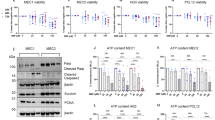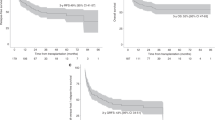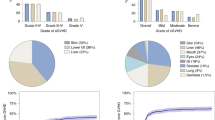Abstract
Chronic graft-versus-host disease (cGVHD), characterized by chronic tissue inflammation and fibrosis involving multiple organs, remains a major complication after allogeneic hematopoietic stem cell transplantation (allo-HSCT). Dimethyl fumarate (DMF) is an anti-inflammatory drug approved for the treatment of multiple sclerosis and psoriasis. We previously reported that DMF effectively inhibits acute GVHD (aGVHD) while preserving the graft-versus-leukemia effect. However, the role of DMF in cGVHD progression remains unknown. Here, we found that DMF administration significantly suppresses follicular helper T cell (Tfh) differentiation, and germinal center formation and alleviates disease severity in different murine cGVHD models. Mechanistically, DMF treatment downregulates IL-21 transcription by activation of Nrf2, thus orchestrating Tfh-related gene programs both in mice and humans. The inhibitory role of DMF on Tfh cell differentiation was diminished in Nrf2 deficient T cells. Importantly, the therapeutic potential of DMF in clinical cGVHD has been validated in human data whereby DMF effectively reduces IL-21 production and Tfh cell generation in peripheral blood mononuclear cells from active cGVHD patients and further attenuates xenograft GVHD. Collectively, our findings reveal that DMF potently inhibits cGVHD development by repressing Tfh cell differentiation via Nrf2, paving the way for the treatment of cGVHD in the clinic.
This is a preview of subscription content, access via your institution
Access options
Subscribe to this journal
Receive 12 print issues and online access
$259.00 per year
only $21.58 per issue
Buy this article
- Purchase on SpringerLink
- Instant access to full article PDF
Prices may be subject to local taxes which are calculated during checkout






Similar content being viewed by others
Data availability
This paper does not report original code. Any additional information required to reanalyze the data reported in this paper is available from the lead contact upon request.
Code availability
This paper does not report original code. Any additional information required to reanalyze the data reported in this paper is available from the lead contact upon request.
References
Zeiser R, Blazar BR. Pathophysiology of chronic graft-versus-host disease and therapeutic targets. N. Engl J Med. 2017;377:2565–79.
Lee SJ. Classification systems for chronic graft-versus-host disease. Blood. 2017;129:30–37.
MacDonald KP, Hill GR, Blazar BR. Chronic graft-versus-host disease: biological insights from preclinical and clinical studies. Blood. 2017;129:13–21.
Jagasia M, Lazaryan A, Bachier CR, Salhotra A, Weisdorf DJ, Zoghi B, et al. ROCK2 inhibition with Belumosudil (KD025) for the treatment of chronic graft-versus-host disease. J Clin Oncol. 2021;39:1888–98.
Marks C, Stadler M, Hausermann P, Wolff D, Buchholz S, Stary G, et al. German-Austrian-Swiss Consensus Conference on clinical practice in chronic graft-versus-host disease (GVHD): guidance for supportive therapy of chronic cutaneous and musculoskeletal GVHD. Br J Dermatol. 2011;165:18–29.
Cutler CS, Koreth J, Ritz J. Mechanistic approaches for the prevention and treatment of chronic GVHD. Blood. 2017;129:22–29.
Le Huu D, Kimura H, Date M, Hamaguchi Y, Hasegawa M, Hau KT, et al. Blockade of Syk ameliorates the development of murine sclerodermatous chronic graft-versus-host disease. J Dermatol Sci. 2014;74:214–21.
Young JS, Wu T, Chen Y, Zhao D, Liu H, Yi T, et al. Donor B cells in transplants augment clonal expansion and survival of pathogenic CD4+ T cells that mediate autoimmune-like chronic graft-versus-host disease. J Immunol. 2012;189:222–33.
Forcade E, Paz K, Flynn R, Griesenauer B, Amet T, Li W, et al. An activated Th17-prone T cell subset involved in chronic graft-versus-host disease sensitive to pharmacological inhibition. JCI Insight 2017;2.
Nurieva RI, Chung Y, Martinez GJ, Yang XO, Tanaka S, Matskevitch TD, et al. Bcl6 mediates the development of T follicular helper cells. Science. 2009;325:1001–5.
Johnston RJ, Poholek AC, DiToro D, Yusuf I, Eto D, Barnett B, et al. Bcl6 and Blimp-1 are reciprocal and antagonistic regulators of T follicular helper cell differentiation. Science. 2009;325:1006–10.
Yu D, Rao S, Tsai LM, Lee SK, He Y, Sutcliffe EL, et al. The transcriptional repressor Bcl-6 directs T follicular helper cell lineage commitment. Immunity. 2009;31:457–68.
Crotty S. T follicular helper cell differentiation, function, and roles in disease. Immunity. 2014;41:529–42.
Crotty S. Follicular helper CD4 T cells (TFH). Annu Rev Immunol. 2011;29:621–63.
Flynn R, Du J, Veenstra RG, Reichenbach DK, Panoskaltsis-Mortari A, Taylor PA, et al. Increased T follicular helper cells and germinal center B cells are required for cGVHD and bronchiolitis obliterans. Blood. 2014;123:3988–98.
Zeiser R, Sarantopoulos S, Blazar BR. B-cell targeting in chronic graft-versus-host disease. Blood. 2018;131:1399–405.
Paz K, Flynn R, Du J, Qi J, Luznik L, Maillard I, et al. Small-molecule BCL6 inhibitor effectively treats mice with nonsclerodermatous chronic graft-versus-host disease. Blood. 2019;133:94–99.
Svenningsson A, Frisell T, Burman J, Salzer J, Fink K, Hallberg S, et al. Safety and efficacy of rituximab versus dimethyl fumarate in patients with relapsing-remitting multiple sclerosis or clinically isolated syndrome in Sweden: a rater-blinded, phase 3, randomised controlled trial. Lancet Neurol. 2022;21:693–703.
Kornberg MD, Bhargava P, Kim PM, Putluri V, Snowman AM, Putluri N, et al. Dimethyl fumarate targets GAPDH and aerobic glycolysis to modulate immunity. Science. 2018;360:449–53.
Casili G, Lanza M, Filippone A, Campolo M, Paterniti I, Cuzzocrea S, et al. Dimethyl fumarate alleviates the nitroglycerin (NTG)-induced migraine in mice. J Neuroinflamm. 2020;17:59.
Han J, Ma S, Gong H, Liu S, Lei L, Hu B, et al. Inhibition of acute graft-versus-host disease with retention of graft-versus-tumor effects by dimethyl fumarate. Front Immunol. 2017;8:1605.
Wan L, Jin Z, Hu B, Lv K, Lei L, Liu Y, et al. IL-Y aggravates murine chronic graft-versus-host disease by enhancing T and B cell responses. Front Immunol. 2020;11:559740.
Wang NH, Halibozek PJ, Yigit B, Zhao H, O’Keefe MS, Sage P, et al. Negative regulation of humoral immunity due to interplay between the SLAMF1, SLAMF5, and SLAMF6 receptors. Front. Immunol. 2015;6.
Wang N, Yigit B, van der Poel CE, Cuenca M, Carroll MC, Herzog RW, et al. The checkpoint regulator SLAMF3 preferentially prevents expansion of auto-reactive B cells generated by graft-vs.-host disease. Front Immunol. 2019;10:831.
Martinez-Blanco A, Dominguez-Pantoja M, Botia-Sanchez M, Perez-Cabrera S, Bello-Iglesias N, Carrillo-Rodriguez P, et al. CD38 deficiency ameliorates chronic graft-versus-host disease Murine Lupus via a B-cell-dependent mechanism. Front Immunol. 2021;12:713697.
Chen X, Sun X, Yang W, Yang B, Zhao X, Chen S, et al. An autoimmune disease variant of IgG1 modulates B cell activation and differentiation. Science. 2018;362:700–5.
Gong H, Ma S, Liu S, Liu Y, Jin Z, Zhu Y, et al. IL-17C mitigates murine acute Graft-vs.-host disease by promoting intestinal barrier functions and treg differentiation. Front Immunol. 2018;9:2724.
Zhao D, Zhang C, Yi T, Lin CL, Todorov I, Kandeel F, et al. In vivo-activated CD103+CD4+ regulatory T cells ameliorate ongoing chronic graft-versus-host disease. Blood. 2008;112:2129–38.
Cai Y, Ma S, Liu Y, Gong H, Cheng Q, Hu B, et al. Adoptively transferred donor IL-17-producing CD4(+) T cells augment, but IL-17 alleviates, acute graft-versus-host disease. Cell Mol Immunol. 2018;15:233–45.
Gong H, Ma S, Chen J, Yang B, Liu S, Liu X, et al. Dendritic cell-derived IL-27 p28 regulates T cell program in pathogenicity and alleviates acute graft-versus-host disease. Signal Transduct Target Ther. 2022;7:319.
Schmitt N, Liu Y, Bentebibel SE, Munagala I, Bourdery L, Venuprasad K, et al. The cytokine TGF-β co-opts signaling via STAT3-STAT4 to promote the differentiation of human T cells. Nat Immunol. 2014;15:856–65.
Nishimori H, Maeda Y, Teshima T, Sugiyama H, Kobayashi K, Yamasuji Y, et al. Synthetic retinoid Am80 ameliorates chronic graft-versus-host disease by down-regulating Th1 and Th17. Blood. 2012;119:285–95.
Jin H, Ni X, Deng R, Song Q, Young J, Cassady K, et al. Antibodies from donor B cells perpetuate cutaneous chronic graft-versus-host disease in mice. Blood. 2016;127:2249–60.
Wu T, Young JS, Johnston H, Ni X, Deng R, Racine J, et al. Thymic damage, impaired negative selection, and development of chronic graft-versus-host disease caused by donor CD4+ and CD8+ T cells. J Immunol. 2013;191:488–99.
Zhang M, Wu Y, Bastian D, Iamsawat S, Chang J, Daenthanasanmak A, et al. Inducible T-cell co-stimulator impacts chronic graft-versus-host disease by regulating both pathogenic and regulatory T cells. Front Immunol. 2018;9:1461.
Wu X, Wang Y, Huang R, Gai Q, Liu H, Shi M, et al. SOSTDC1-producing follicular helper T cells promote regulatory follicular T cell differentiation. Science. 2020;369:984–8.
Yao Y, Yang Y, Guo W, Xu L, You M, Zhang YC, et al. METTL3-dependent m(6)A modification programs T follicular helper cell differentiation. Nat Commun. 2021;12:1333.
Wu Q, Wang Q, Mao G, Dowling CA, Lundy SK, Mao-Draayer Y. Dimethyl Fumarate selectively reduces memory T cells and shifts the balance between Th1/Th17 and Th2 in multiple sclerosis patients. J Immunol. 2017;198:3069–80.
Sofi MH, Tian L, Schutt S, Khan I, Choi HJ, Wu Y, et al. Ceramide synthase 6 impacts T-cell allogeneic response and graft-versus-host disease through regulating N-RAS/ERK pathway. Leukemia. 2022;36:1907–15.
Casili G, Cordaro M, Impellizzeri D, Bruschetta G, Paterniti I, Cuzzocrea S, et al. Dimethyl fumarate reduces inflammatory responses in experimental colitis. J Crohns Colitis. 2016;10:472–83.
Sulaimani J, Cluxton D, Clowry J, Petrasca A, Molloy OE, Moran B, et al. Dimethyl fumarate modulates the Treg-Th17 cell axis in patients with psoriasis. Br J Dermatol. 2021;184:495–503.
Wu Y, Schutt S, Paz K, Zhang M, Flynn RP, Bastian D, et al. MicroRNA-17-92 is required for T-cell and B-cell pathogenicity in chronic graft-versus-host disease in mice. Blood. 2018;131:1974–86.
Nakayamada S, Kanno Y, Takahashi H, Jankovic D, Lu KT, Johnson TA, et al. Early Th1 cell differentiation is marked by a Tfh cell-like transition. Immunity. 2011;35:919–31.
Zeng H, Cohen S, Guy C, Shrestha S, Neale G, Brown SA, et al. mTORC1 and mTORC2 Kinase signaling and glucose metabolism drive follicular helper T cell differentiation. Immunity. 2016;45:540–54.
Liu L, Hu L, Long H, Zheng M, Hu Z, He Y, et al. LncRNA IL21-AS1 interacts with hnRNPU protein to promote IL21 overexpression and aberrant differentiation of Tfh cells in systemic lupus erythematosus. Clin Transl Med. 2022;12:e1117.
Flynn R, Paz K, Du J, Reichenbach DK, Taylor PA, Panoskaltsis-Mortari A, et al. Targeted Rho-associated kinase 2 inhibition suppresses murine and human chronic GVHD through a Stat3-dependent mechanism. Blood. 2016;127:2144–54.
Xiang P, Zhang Y, Qu X, Chen Y, Xu Y, Li X, et al. Xiehuo Xiaoying decoction inhibits Tfh cell expansion and promotes Tfr cell amplification to ameliorate Graves’ disease. J Ethnopharmacol. 2023;301:115826.
Yang J, Yang X, Yang J, Li M. Baicalin ameliorates lupus autoimmunity by inhibiting differentiation of Tfh cells and inducing expansion of Tfr cells. Cell Death Dis. 2019;10:140.
Zhu Y, Zhao Y, Zou L, Zhang D, Aki D, Liu YC. The E3 ligase VHL promotes follicular helper T cell differentiation via glycolytic-epigenetic control. J Exp Med. 2019;216:1664–81.
Yao Y, Chen Z, Zhang H, Chen C, Zeng M, Yunis J, et al. Selenium-GPX4 axis protects follicular helper T cells from ferroptosis. Nat Immunol. 2021;22:1127–39.
Deng J, Chen Q, Chen Z, Liang K, Gao X, Wang X, et al. The metabolic hormone leptin promotes the function of T(FH) cells and supports vaccine responses. Nat Commun. 2021;12:3073.
Cho SH, Raybuck AL, Stengel K, Wei M, Beck TC, Volanakis E, et al. Germinal centre hypoxia and regulation of antibody qualities by a hypoxia response system. Nature. 2016;537:234–8.
Acknowledgements
This work was supported by the National Key R&D Program of China (2022YFC2502700), National Natural Science Foundation of China (No. 81974001, 82170222, 81900180, 82060035, 82300250, 82370215, 82330008, 82460047, and 82020108003), Priority Academic Program Development of Jiangsu Higher Education Institutions (PAPD), Jiangsu Province Capability Improvement Project through Science, Technology and Education (CXZX202201), the Jiangsu Social Development Program (BE2018651), Natural Science Foundation of Jiangsu Province (BK20211070, BK20220246, BK20240354), Suzhou Science and Technology Program Project (SLT201911, SKY2021039, SKY2022132, SSD2024037 and SKY2023047) and Translational Research Grant of NCRCH (2021ZKQC01, 2021ZKQC02). We thank Dr. Zhian Chen from the University of Queensland for his valuable suggestions.
Author information
Authors and Affiliations
Contributions
HG, JH, YX and DW designed the study and supervised the research. FL, HG, XW, XL and YL performed the experiments and analyses. XW, CL, YW, LL and JC contributed to the experiments. SM, HS and DY analyzed the sequencing data and provided expertise. SM, FL, JH, HG, YX and DW wrote, edited, and reviewed the manuscript. All authors have read and approved the article.
Corresponding authors
Ethics declarations
Competing interests
The authors declare no competing interests.
Ethics approval and consent to participate
All patient samples and additional clinical information used in this study were collected by the First Affiliated Hospital of Soochow University with informed consent from all patients. This study was approved by the Medical Ethics Committee of the First Affiliated Hospital of Soochow University (2024639) in accordance with the Declaration of Helsinki.
Additional information
Publisher’s note Springer Nature remains neutral with regard to jurisdictional claims in published maps and institutional affiliations.
Supplementary information
Rights and permissions
Springer Nature or its licensor (e.g. a society or other partner) holds exclusive rights to this article under a publishing agreement with the author(s) or other rightsholder(s); author self-archiving of the accepted manuscript version of this article is solely governed by the terms of such publishing agreement and applicable law.
About this article
Cite this article
Lyu, F., Gong, H., Wu, X. et al. Dimethyl fumarate ameliorates chronic graft-versus-host disease by inhibiting Tfh differentiation via Nrf2. Leukemia 39, 473–481 (2025). https://doi.org/10.1038/s41375-024-02475-5
Received:
Revised:
Accepted:
Published:
Issue date:
DOI: https://doi.org/10.1038/s41375-024-02475-5
This article is cited by
-
SENP1 inhibits aerobic glycolysis in Aβ1-42-incubated astrocytes by promoting PUM2 deSUMOylation
Cell Biology and Toxicology (2025)



